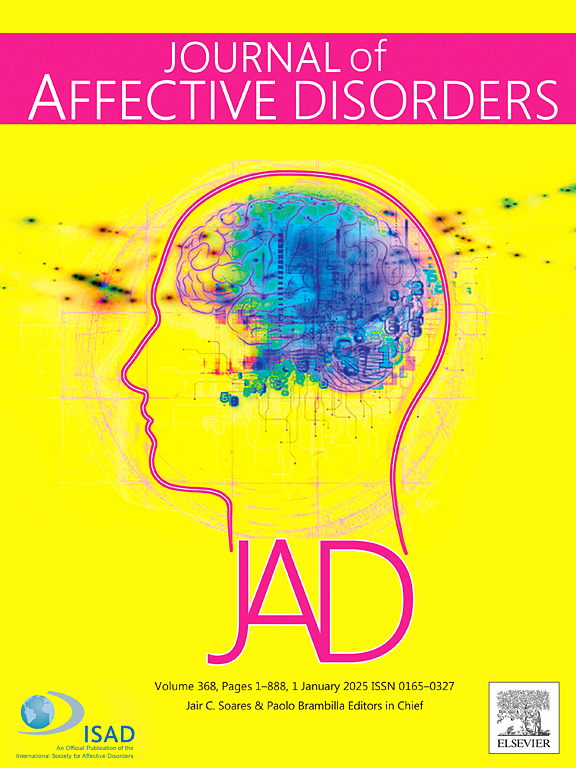Quantifying gender differences in the impact of internet addiction on adolescent depression: A causal inference approach
IF 4.9
2区 医学
Q1 CLINICAL NEUROLOGY
引用次数: 0
Abstract
Background
The rising prevalence of adolescent depression in China has raised concerns about internet influence. This study identified predictors of internet addiction (IA) and quantified its gender-specific impact on depression.
Method
In April–May 2023, 8176 adolescents from six (6) junior high schools in Henan, China, were randomly sampled. IA and depression were assessed via the 20-item internet addiction test (IAT) and 10-item Center for Epidemiologic Studies Depression (CESD-10) scale, respectively. IA's impact on depression was analyzed using four approaches: IPW (confounder weighting), DML (high-dimensional control), PSM (covariate balancing), and RA (residual adjustment).
Results
Among the males, 31.8 % reported depression and 17.7 % reported IA while females, 49.4 % reported depression and 21.3 % IA. The mean ages were 14.5 ± 0.94 (males) and 14.4 ± 0.93 (females). DML revealed the overall effect of 0.22 (95 % CI: 0.17–0.23; p < 0.001), higher in males (95 % CI: 0.23, 95 % CI: 0.18–0.31) than females (0.17, 95 % CI: 0.11–0.23). IPW estimated an effect of 0.30 (95 % CI: 0.25–0.34; p < 0.001), also higher in males (0.34, 95 % CI: 0.28–0.39) than females (0.29, 95 % CI: 0.23–0.36). PSM and RA yielded similar results. Predictors of IA included low self-esteem, history of negative life events, poor sleep quality, and one-child family status.
Conclusion
Internet addiction (IA) exacerbates adolescent depression, disproportionately affecting males. Addressing self-esteem, negative life events, poor sleep, and one-child family challenges can mitigate IA's effects. Gender-sensitive interventions, school-based programs, and parental guidance are critical.
背景:中国青少年抑郁症发病率的上升引起了人们对网络影响的关注。本研究确定了网络成瘾(IA)的预测因素,并量化了不同性别的网络成瘾对抑郁症的影响:2023年4月至5月,随机抽取了中国河南省6所初中的8176名青少年。分别通过20项网络成瘾测试(IAT)和10项流行病学研究中心抑郁量表(CESD-10)评估IA和抑郁。采用四种方法分析了网络成瘾对抑郁症的影响:IPW(混杂因素加权)、DML(高维控制)、PSM(协变量平衡)和RA(残差调整):男性中,31.8%患有抑郁症,17.7%患有内分泌失调;女性中,49.4%患有抑郁症,21.3%患有内分泌失调。平均年龄为 14.5 ± 0.94(男性)和 14.4 ± 0.93(女性)。DML 显示的总体效应为 0.22(95 % CI:0.17-0.23;P 结论:网络成瘾(IA)会加剧青少年抑郁,对男性的影响尤为严重。解决自尊、负面生活事件、睡眠质量差和独生子女家庭挑战等问题可减轻网瘾的影响。对性别问题有敏感认识的干预措施、以学校为基础的计划以及父母的指导至关重要。
本文章由计算机程序翻译,如有差异,请以英文原文为准。
求助全文
约1分钟内获得全文
求助全文
来源期刊

Journal of affective disorders
医学-精神病学
CiteScore
10.90
自引率
6.10%
发文量
1319
审稿时长
9.3 weeks
期刊介绍:
The Journal of Affective Disorders publishes papers concerned with affective disorders in the widest sense: depression, mania, mood spectrum, emotions and personality, anxiety and stress. It is interdisciplinary and aims to bring together different approaches for a diverse readership. Top quality papers will be accepted dealing with any aspect of affective disorders, including neuroimaging, cognitive neurosciences, genetics, molecular biology, experimental and clinical neurosciences, pharmacology, neuroimmunoendocrinology, intervention and treatment trials.
 求助内容:
求助内容: 应助结果提醒方式:
应助结果提醒方式:


